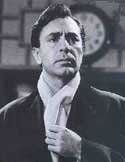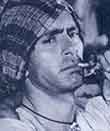arpita
Prime VIP
Balraj Sahni

Balraj Sahni was the first hero who refused to fit the mould. In an era when hysterics rather than histrionics ruled the roost, he was the one actor who stood apart from the rest with his dignified, graceful and understated performances. He lived his roles with an honesty and intelligence that is rare to find and managed to straddle both the world of art and commercial cinema with ease.
Born in Rawalpindi, Balraj Sahni studied at the Government College of Lahore, graduating in Literature. He taught Hindi and English at Shantiniketan and wrote his first compilation of Hindi fiction, Shahzadon ka Drink in 1936. He also worked as a journalist and briefly as a radio announcer for BBC`s Hindi service, besides setting up the Monday Morning journal in Delhi. A man with a genuine social conscience with leanings towards the Left, Balraj became a key player in the Indian Peoples` Theatre Association (IPTA) when he came to Bombay in 1947.
He began his tryst with Hindi cinema with a walk-on part in Phani Majumdar`s Insaaf (1946). His first real film was also director-writer K A Abbas`s first, Dharti Ke Lal (1946), the only film produced by IPTA. While Balraj Sahni won accolades for his performance in the film, it didn`t do much to kickstart his career. Meanwhile, with the IPTA becoming a political hotbed for Communists. In 1951, the actor was arrested as part of a government campaign against communists, He was given special permission to shoot for Hulchul (1951) and would be escorted to the sets by cops. However, he was released very soon and went on to notch another sterling performance in Zia Sarhad`s Hum Log (1951) as an unemployed youth.
 Bimal Roy`s Do Bigha Zameen happened in 1953 and is perhaps Balraj Sahni`s most wellknown film. A real tour de force performance! Balraj Sahni actually plied a rickshaw in Calcutta for 15 days with son Parikshit and daughter as passengers, besides interacting with other rickshawpullers.! So studying for a role was not something invented by the likes of Shabana Azmi, Smita Patil and Naseeruddin Shah. For his role in Kabuliwallah (1961), Balraj Sahni actually went and lived for a month with kabuliwallahs.
Bimal Roy`s Do Bigha Zameen happened in 1953 and is perhaps Balraj Sahni`s most wellknown film. A real tour de force performance! Balraj Sahni actually plied a rickshaw in Calcutta for 15 days with son Parikshit and daughter as passengers, besides interacting with other rickshawpullers.! So studying for a role was not something invented by the likes of Shabana Azmi, Smita Patil and Naseeruddin Shah. For his role in Kabuliwallah (1961), Balraj Sahni actually went and lived for a month with kabuliwallahs.
To come back to `Do Bigha Zameen`, if Bimal gave us a truly human film, Balraj Sahni gave a truly moving performance as Shambhu and literally becomes Shambhu. The culminating scene in the film is unforgettable with the wretchedness of human defeat writ large on Sahni`s face as he sees the factory built on his land.
Balraj Sahni continued his commitment to good, serious cinema with films like `Garam Coat` (1955), `Anuradha` (1960) and `Kabuliwallah.` But he also dabbled in commercial cinema in lead roles opposite actresses like Nargis, (`Lajwanti, Ghar Sansar,` 1958), Meena Kumari (`Satta Bazaar` 1959, `Bhabhi Ki Chudiyan` 1961), Vyjayantimala (`Kathputli` 1957) and Nutan (`Seema` 1955, `Sone ki Chidiya` 1958). Even in the commercial films, as in the offbeat ones, Balraj Sahni brought a rare dignity, depth and grace to his portrayals.
 In the Sixties, Balraj Sahni shifted to character roles and left his mark with strong performances in films like Haqeeqat (1964), Waqt (1965), Do Raaste (1969), Ek Phool Do Mali (1969) and Mere Humsafar (1970). He also directed a film `Lal Batti` (1957), a film set in a train and on a lonely railway platform where passengers are forced to spend a night at the time of India`s Independence.
In the Sixties, Balraj Sahni shifted to character roles and left his mark with strong performances in films like Haqeeqat (1964), Waqt (1965), Do Raaste (1969), Ek Phool Do Mali (1969) and Mere Humsafar (1970). He also directed a film `Lal Batti` (1957), a film set in a train and on a lonely railway platform where passengers are forced to spend a night at the time of India`s Independence.
His final triumph came with MS Sathyu`s Garam Hawa (1973). It was a befitting swan song for this great actor. The film is set in Agra after the major exodus of Partition and chronicles the plight of the minority Muslims in North India. He responded with an absolutely brilliant performance, perhaps his greatest ever, as he typified the hapless Muslim caught in the throes of a national identity crisis.
Balraj Sahni also wrote the story and screenplay for the Dev Anand starrer Baazi (1951), directed by Guru Dutt. He wrote extensively, including novels and an autobiography. He remained a staunch Left activist all through his life and was part of cultural delegates to the erstwhile Soviet Union and China. His writings and speeches were compiled by Communist leader PC Joshi in the book Balraj Sahni: An Intimate Portrait (1974). He is survived by his son, actor Parikshit Sahni. His brother Bhisham Sahni, a renowned figure in the world of Hindi literature, will best be remembered by ordinary folks as the writer of Tamas, that stunning saga of Partition.

Balraj Sahni was the first hero who refused to fit the mould. In an era when hysterics rather than histrionics ruled the roost, he was the one actor who stood apart from the rest with his dignified, graceful and understated performances. He lived his roles with an honesty and intelligence that is rare to find and managed to straddle both the world of art and commercial cinema with ease.
Born in Rawalpindi, Balraj Sahni studied at the Government College of Lahore, graduating in Literature. He taught Hindi and English at Shantiniketan and wrote his first compilation of Hindi fiction, Shahzadon ka Drink in 1936. He also worked as a journalist and briefly as a radio announcer for BBC`s Hindi service, besides setting up the Monday Morning journal in Delhi. A man with a genuine social conscience with leanings towards the Left, Balraj became a key player in the Indian Peoples` Theatre Association (IPTA) when he came to Bombay in 1947.
He began his tryst with Hindi cinema with a walk-on part in Phani Majumdar`s Insaaf (1946). His first real film was also director-writer K A Abbas`s first, Dharti Ke Lal (1946), the only film produced by IPTA. While Balraj Sahni won accolades for his performance in the film, it didn`t do much to kickstart his career. Meanwhile, with the IPTA becoming a political hotbed for Communists. In 1951, the actor was arrested as part of a government campaign against communists, He was given special permission to shoot for Hulchul (1951) and would be escorted to the sets by cops. However, he was released very soon and went on to notch another sterling performance in Zia Sarhad`s Hum Log (1951) as an unemployed youth.

To come back to `Do Bigha Zameen`, if Bimal gave us a truly human film, Balraj Sahni gave a truly moving performance as Shambhu and literally becomes Shambhu. The culminating scene in the film is unforgettable with the wretchedness of human defeat writ large on Sahni`s face as he sees the factory built on his land.
Balraj Sahni continued his commitment to good, serious cinema with films like `Garam Coat` (1955), `Anuradha` (1960) and `Kabuliwallah.` But he also dabbled in commercial cinema in lead roles opposite actresses like Nargis, (`Lajwanti, Ghar Sansar,` 1958), Meena Kumari (`Satta Bazaar` 1959, `Bhabhi Ki Chudiyan` 1961), Vyjayantimala (`Kathputli` 1957) and Nutan (`Seema` 1955, `Sone ki Chidiya` 1958). Even in the commercial films, as in the offbeat ones, Balraj Sahni brought a rare dignity, depth and grace to his portrayals.

His final triumph came with MS Sathyu`s Garam Hawa (1973). It was a befitting swan song for this great actor. The film is set in Agra after the major exodus of Partition and chronicles the plight of the minority Muslims in North India. He responded with an absolutely brilliant performance, perhaps his greatest ever, as he typified the hapless Muslim caught in the throes of a national identity crisis.
Balraj Sahni also wrote the story and screenplay for the Dev Anand starrer Baazi (1951), directed by Guru Dutt. He wrote extensively, including novels and an autobiography. He remained a staunch Left activist all through his life and was part of cultural delegates to the erstwhile Soviet Union and China. His writings and speeches were compiled by Communist leader PC Joshi in the book Balraj Sahni: An Intimate Portrait (1974). He is survived by his son, actor Parikshit Sahni. His brother Bhisham Sahni, a renowned figure in the world of Hindi literature, will best be remembered by ordinary folks as the writer of Tamas, that stunning saga of Partition.
